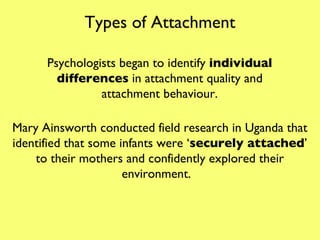
Mary Ainsworth's Naturalistic Observation of Mother-Infant Attachment
- 1. Types of Attachment Psychologists began to identify individual differences in attachment quality and attachment behaviour. Mary Ainsworth conducted field research in Uganda that identified that some infants were ‘ securely attached ’ to their mothers and confidently explored their environment.
- 2. Mary Ainsworth concluded that the ‘securely attached infants’ used their mothers as a ‘ secure base ’.
- 3. Naturalistic Observation In a naturalistic observation behaviour is studied in a natural situation where everything has been left as it is normally. Mary Ainsworth conducted a longitudinal naturalistic observation of mother infant relationships.
- 4. Link to research methods Turn to p. 86 - 87 Read p.86 ‘Examples of different kinds of observation’ Read p.87 ‘Observational techniques’ Key terms : Naturalistic observation , Structured observations, and Controlled observation.
- 5. Link to research methods Turn to p. 91 Read the table headed: Evaluation of observational research. ‘ With reference to the naturalistic observation conducted by Ainsworth in Uganda give one advantage and one weakness of studying children in this way’ (2+2) Use the information in the table to answer the question below.
- 6. The Baltimore Study : Ainsworth et al ., 1971 Why was Ainsworth interested in studying mother infant relationships in an American city?
- 7. How many mothers were involved in the study? Any problems with the sample? Read the section on p.40 on the Baltimore study. How had the mothers with children who were classified as ‘secure’ behaved with their children in the first 3 months?
- 8. How could you use Ainsworth’s early studies to evaluate learning theory? How could you use Ainsworth’s early studies to evaluate Bowlby’s theory of attachment?
- 9. The Strange Situation (1969, 1978) This is a really important study its named on the specification so you could get questions on it. Learn it well. Click this for a video
- 11. 4. What behaviour is this episode intended to test?
- 12. 5. What behaviour is this episode intended to test?
- 13. 6. S - - - - - - - - - A - - - - - - -
- 14. 7. Stranger enters and offers comfort.
- 15. Write a description of this episode.
- 16. Answer the following questions (a) Ainsworth et al used observation in their study of attachment types. (i) Did they use an observational technique or an observational method? (ii) What is the difference between these two kinds of observation? (b) There are several IV’s and DV’s in this study Identify one IV and one DV and explain how these were operationalised.
- 17. (C) (i) What was the target population of the Ainsworth study? (ii) Suggest one technique that Ainsworth might have employed to select their participants. (d) The Strange Situation has been accused of lacking validity. Explain what this means in the context of this study. (e) How could you assess the reliability of the strange situation? (f) Identify one ethical issue arising from this research.
- 18. You need to know the 4 attachment types well. You need to be able to describe them but also to recognise them. What type of behaviours would be typical of a securely attached child? How would you recognise the behaviour of a child with an insecure attachment?
- 19. Some of the questions on the exam paper will require you to apply your knowledge not just reproduce it. Below is an example. Andrea has noticed that her two sons are quite different. When she gets home from work the first thing Sam does is to run to her and give her a great big hug, whilst she has to go to find rob to make sure he is okay. When a plumber came to the house the other day Sam was fine with him, but Rob wouldn’t stop crying and appeared scared. (a) Identify: (i) the type of attachment shown by Rob. (1 mark) (II) The type of attachment shown by Sam. (1 mark) (b) Explain how the type of attachment shown by each child could be assessed. (4 marks)